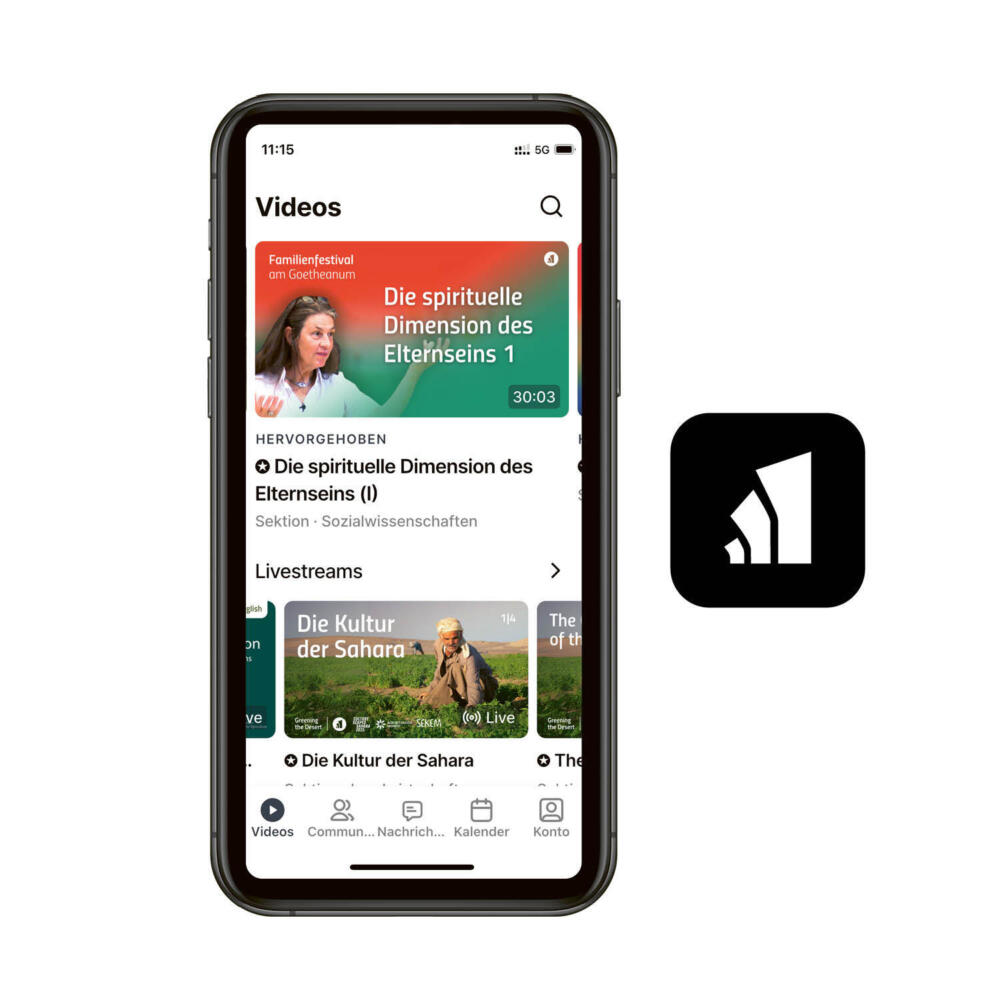GoetheanumTV – carrying the Goetheanum in your pocket
Goetheanum TV was conceived during Covid to enable participation in anthroposophical events. Its range of offerings has since then been further developed and can now be downloaded as an app onto your smartphone.
Sebastian Jüngel Have the people who joined Goetheanum TV during Covid stayed with it or did they leave again?
Louis Defèche It is difficult to say if the users are the same because there are always some who leave and new ones arrive, but the number of regular visits and subscriptions has certainly risen steadily since the pandemic.
Diversity of people and topics
Jüngel Why is this?
Defèche I can only guess, but people seem to have a profound need to access anthroposophical content and to follow what is going on at the Goetheanum even from a distance. It is also true to say that our infrastructure and the amount of content available have grown immensely. Compared to other videos available in the field of anthroposophy, the Goetheanum offers a great diversity of themes because it is such a special place that welcomes so many people from all over the world to its twelve sections, its stage and its artistic events.
Jüngel Although Goetheanum TV is rather a new project, there have been some changes in the programme. What is your experience with the recording of lectures and other formats?
Defèche There is a big difference between recording a lecture during a conference, organizing an interview, a course or debate and producing a reportage. Some formats are easy to put together while others require a lot of organization and time and need more input.
We try to provide a diversity of content and a good balance between paid-for content and free content that we broadcast to air topics which are relevant to society today. What I find surprising and pleasing is to see how the abundance and vitality of the Goetheanum becomes globally accessible thanks to this video platform.
One of the challenging aspects is the variety of languages. When we livestream major conferences, we sometimes work with seven languages at the same time. Originally, we had planned to offer four languages on a regular basis, but that turned out to be too complex and we had to limit ourselves to two languages – German and English – for regular productions. However, that does not mean that there are no other languages on the platform; they just appear irregularly.
We also noticed that everyone needs to go through a learning process to get used to the video format. It is not always easy to find the right way of speaking in front of a camera.
Close to people
Jüngel The accessibility of Goetheanum TV has also been further developed. Currently, Goetheanum TV can also be reached via an app that has been optimized for smartphones. Has this made a difference to the demand?
Defèche Yes, we are working constantly on improving the platform to keep access as simple and convenient as possible. This summer we published an app for smartphones, which is, as far as I know, the first Goetheanum app. The advantage of an app is that it creates a kind of little ‘home’, a little house of anthroposophy on people’s personal smartphone – as if you were carrying the Goetheanum in your pocket. You can download videos to watch offline and receive notifications when new videos are available.
Around 500 people have downloaded the app so far, but it is not possible to say at this point whether it has had an influence on the number of subscriptions.
Jüngel How does Goetheanum TV complement what the Goetheanum is offering anyway, such as the weekly magazine Das Goetheanum, the newsletter Anthroposophy Worldwide, the Section newsletters and the books published by the Goetheanum Press (Verlag am Goetheanum)?
Defèche What makes the video format particularly attractive are the voices and faces, the proximity to people it creates. With written text the distance between readers and author is much greater because the medium of script – however magical and relevant it may be – does not allow for such an immediate perception of the other person, their gestures, facial expressions, vocal qualities, rhythms and the musicality of their speech in a wider sense. Video is much more spontaneous than writing because you keep editing a text while a video is recorded in the moment.
Partnerships
Jüngel What does Goetheanum TV wish for?
Defèche The video production team is happy about growing interest and increasing user numbers. The more subscriptions we have, the more interesting the formats that we can produce. On the other hand, we must enhance and improve our cooperation with all the Sections of the School of Spiritual Science and find the right formats and forms of working together.
We welcome feedback from users via the comment function. There is even an area for sharing impressions on the platform where anyone can leave comments or share their own short videos. Receiving ideas and materials from the whole world can help us improve our work.
We are now seeking to build up partnerships with anthroposophical organizations by offering institutional subscriptions. This means that an enterprise or organization can subscribe for a total of 50, 100, 500 or more individuals and offer this access to their members, students or staff as cultural and educational material.
Generally speaking, the platform is increasingly developing into a place of further education in the field of anthroposophy. We would love this to make a crucial contribution by bringing the anthroposophical approach closer to a larger number of people so it can be deepened and made fruitful. This is what gives meaning to our work.
Louis Defèche is executive director of Goetheanum TV.
Web GoetheanumTV

